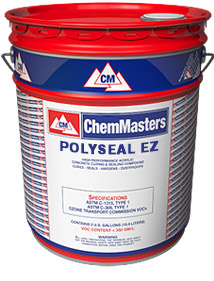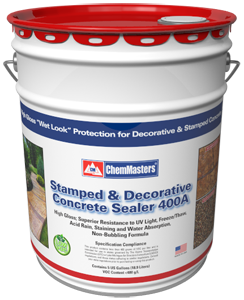Seal the Deal is intended to be an informative and educational publication for ChemMasters’ network of independent manufacturer’s representatives, distributors and contractors. We don’t want to make you chemical engineers, but we do want to help you feel better informed and more comfortable discussing construction chemicals. If there are specific products or topics you would like to see addressed in a future issue, please contact
John Fauth.
Using Decorative Concrete Sealers in Hot Weather
Decorative concrete sealers are most often solvent-based chemistries because they:
- Deepen and enrich the color of decorative concrete and stains
- Have higher gloss levels and improved aesthetics
- Are lacquer systems that can be readily re-sealed
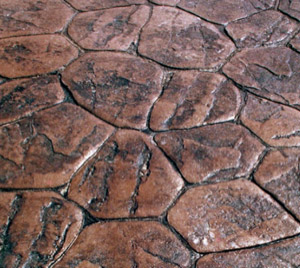
Solvent-based sealers enrich colors on decorative concrete.
However, solvent-based products can become more difficult to use in hot weather applications, particularly if they utilize exempt solvent systems inherent to “low-VOC” states and Canada. And although low-VOC sealers can be less user friendly, all solvent-based products present
specific challenges when being used in hot weather.
Aesthetics
Because solvent-based sealers are frequently used on decorative concrete, they are often being used to improve aesthetic qualities rather than simply protect concrete.
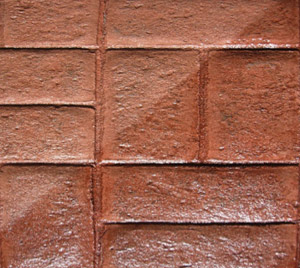
Gloss Restorer SRT returns gloss & color to dull, weathered sealer.
- Sealers are regularly applied when the sealer loses its gloss, rather than when it has worn away. Over time this can result in a build-up of sealer coating thickness and becomes particularly troublesome in hot weather as elevated substrate and ambient air temperatures cause
the sealer to “skin over”, trapping solvent within the coating and forming bubbles.
Solution: Apply sealer less frequently. Use Gloss Restorer SRT to return gloss and color to dull and weathered sealer without increasing coating thickness.
- Sealers are often over applied in order to achieve a desired “depth of gloss”, causing them to lose their permeability (breathability). This traps water vapor beneath the sealer coating and creates a pressure that can disbond the sealer from the concrete surface, causing it
to appear white or even delaminate.
Solution: Reseal using very thin coats.

Sealer that is no longer breathable can appear white.
Solvent Evaporation
In order to meet strict limits on Volatile Organic Compounds (V.O.C.’s), sealer manufacturers must use faster evaporating V.O.C. exempt solvents.
- As exempt solvents evaporate, they represent a smaller percentage of the wet sealer being applied to the concrete. This increases the percent solids of the coating and unintentionally increases the coating thickness. As we’ve covered earlier, this traps water vapor beneath
the sealer coating and creates a pressure that can disbond the sealer from the concrete surface, causing it to appear white or even delaminate.
Solution: Use a low-VOC sealer that has been formulated to evaporate more slowly.
Bubble Resistant Low-VOC Cure and Seal
Polyseal EZ is a proprietary formulation that resists bubble formation, cobwebbing, and stringing commonly associated with low-VOC cure and seals.
Slow Evaporating, Low-VOC High Gloss “Wet Look” Sealer
Film forming sealer manufactured to provide 200-300% more working time on stamped, exposed aggregate, and other decorative concrete than traditional low-VOC sealers.
- Fast evaporating exempt solvents can become stringy and “cobweb” on rollers. The natural response is to re-wet the roller cover in sealer and roll over the cobwebs which increases the coating thickness, decreases breathability, etc.
Solution: Use a low-VOC sealer that has been formulated to evaporate more slowly.
Bubble Resistant Low-VOC Cure and Seal
Polyseal EZ is a proprietary formulation that resists bubble formation, cobwebbing, and stringing commonly associated with low-VOC cure and seals.
Slow Evaporating, Low-VOC High Gloss “Wet Look” Sealer
Film forming sealer manufactured to provide 200-300% more working time on stamped, exposed aggregate, and other decorative concrete than traditional low-VOC sealers.
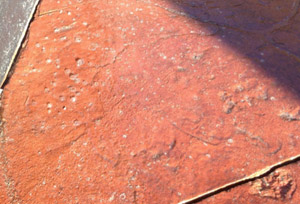
Outgassing can form large bubbles in concrete sealer.
Outgassing
Concrete surfaces contain many capillaries and pores. As air in these void structures warms, it expands. Sealer that is still in a pliable phase can “blow a bubble” under this pressure/expansion. Outgassing is most common in deep recesses and joints.
- Solution: Apply sealer in the cooler parts of the morning or evening hours. Use a low-VOC sealer that has been formulated to evaporate more slowly.
Solar Energy
Direct sunlight raises substrate temperatures, contributing to increased likelihood of outgassing and rapid solvent evaporation.
- Solution: Apply sealer in the cooler parts of the morning or evening hours. Use a low-VOC sealer that has been formulated to evaporate more slowly.
Fortunately, a series of “Tech Tips” was created to provide easy to understand repairs for the most common issues associated with hot weather application of solvent-based sealers, including:
- Bubble Formation – Bubbles that form in the sealer coating as it cures.
- Delamination – Sealer that fails to bond to the concrete surface.
- Whitening – Sealer that has been over applied and is no longer breathable.
- Roller or Spray Patterns – Sealer that has been applied unevenly.
Each of these helpful Tech Tips, and more, can be found in ChemMasters University on the ChemMasters website. There’s even a helpful article on the proper means of Maintaining Decorative Concrete Sealers that can help you avoid problems in the first place.
In the event you do not find Tech Tip answers to your questions, feel free to call our Technical Service Department at 1-800-486-7866.
Seal the Deal is intended to be an informative and educational publication for ChemMasters’ network of independent manufacturer’s representatives, distributors and contractors. We don’t want to make you chemical engineers, but we do want to help you feel better informed and more comfortable discussing construction chemicals. If there are specific products or topics you would like to see addressed in a future issue, please contact
John Fauth.

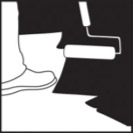 Seal the Deal
Seal the Deal


